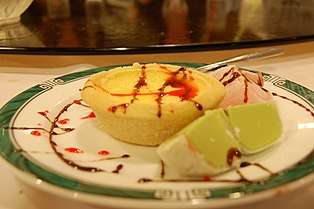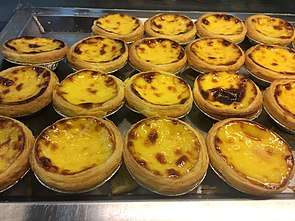Egg tart
The egg tart (simplified Chinese: 蛋挞; traditional Chinese: 蛋撻; pinyin: dàntǎ (in Mandarin); Jyutping: daan6 taat1; Cantonese Yale: daahn tāat) is a kind of custard tart found in Cantonese cuisine deriving from the English custard tart and Portuguese pastel de nata. The dish consists of an outer pastry crust filled with egg custard. Egg tarts are often served at dim sum restaurants and cha chaan tengs.
 Different variations of egg tarts | |
| Alternative names | Daahn tāat; po tat |
|---|---|
| Type | Pastry |
| Course | Dessert, snack |
| Place of origin | Guangzhou, China |
| Main ingredients | Flour, butter, sugar, egg, custard, milk |
| Egg tart | |||||||||||||||
|---|---|---|---|---|---|---|---|---|---|---|---|---|---|---|---|
| Traditional Chinese | 蛋撻 | ||||||||||||||
| Simplified Chinese | 蛋挞 | ||||||||||||||
| Literal meaning | egg tart | ||||||||||||||
| |||||||||||||||
History
The egg tart started being sold in the early 20th century in Guangzhou, Guangdong province, inspired by the English custard tart. Guangzhou's status as the only port accessible to foreign traders led to the development of Cantonese cuisine having many outside influences.[1] As Guangzhou's economy grew from trade and interaction with Britain, pastry chefs at the Western-style department stores in the city were asked to invent new pastries weekly to attract customers from competitors. The egg tart, featuring a lard-based puff pastry crust and a filling similar to steamed egg pudding (燉蛋), was invented by a department store for one of these "Weekly Special" competitions.[2] The Zhen Guang Restaurant in Guangzhou is also credited with inventing the Chinese egg tart.[2] As Macau was a Portuguese colony, Macau-style egg tarts are a variation of the pastel de nata but they have been influenced by Guangzhou-style egg tarts.
Variations
Hong Kong

Egg tarts were introduced to Hong Kong via Guangzhou in the 1940s but initially could only be found in higher-end Western-style restaurants. In the 1960s, cha chaan tengs began to serve egg tarts, popularizing the pastry with the working-class Hong Kong population.[3][4]
Hong Kong egg tarts are typically smaller and served in twos or threes, in contrast to the original Guangzhou egg tarts which were larger and could be served as a single item. The custard filling may be flavored with chocolate, green tea, abalone or bird's nest, and the outer shell may be made with shortcrust pastry or puff pastry.[2][5][3]
In June 2014, the technique of egg tart production was formally included in the Intangible Cultural Heritage Inventory of Hong Kong.[6]
Macau

In 1989, British pharmacist Andrew Stow and his wife Margaret Wong opened Lord Stow's Bakery in Coloane, where they sold a Macau-style egg tart that attempted to recreate the pastel de nata.[7] This variation is referred to in Chinese as "po tat" ("Portuguese tart").[8][9] In 1999, Wong sold the recipe to KFC, which then introduced the Macau-style pastel de nata to other Asian countries including Singapore and Taiwan.[3][10]
In contrast to the Hong Kong-style egg tart, the Macau-style egg tart features a caramelized browned top.[8]
See also
References
- "除了奶茶,還有蛋撻 - 香港文匯報". paper.wenweipo.com. Retrieved 24 June 2019.
- "Hong Kong egg tarts are not vegetarian – and here's why". South China Morning Post. 13 December 2018. Retrieved 10 November 2019.
- "澳門蛋撻的背後:夫妻離婚,肯德基爺爺竟成最大贏家!" (in Chinese). Retrieved 25 June 2019.
- Gao, Sally. "Everything You Need To Know About The Hong Kong Egg Tart". Culture Trip. Retrieved 10 November 2019.
- Fulton, Michaela. "Hong Kong's Top 10 Baked Goods And Pastries". Culture Trip. Retrieved 10 November 2019.
- "非物質文化遺產普查 菠蘿包蛋撻上榜 - 東方日報". orientaldaily.on.cc. Retrieved 24 June 2019.
- "How a British pharmacist-turned-baker created Macau's most edible icon: the Portuguese egg tart". South China Morning Post. 13 April 2016. Retrieved 11 November 2019.
- "The surprising origin of Macau's Portuguese egg tarts - Taipei Times". www.taipeitimes.com. Retrieved 10 November 2019.
- Jamshed, Zahra (22 October 2019). "'Like the tart, I never change': The secret behind Macao's most famous dessert". CNN Travel. Retrieved 11 November 2019.
- Loh, Larry. "KFC brings Macau-style egg tarts to Singapore | CNN Travel". '. Retrieved 11 November 2019.
External links
| Wikimedia Commons has media related to Egg tarts. |